Every fallen aircraft has a story. A final, silent message whispered among twisted metal and scattered debris. But how do you hear the secrets of a plane that lies in pieces, miles deep at the bottom of the ocean, or shattered across a remote mountain peak? The answer is locked inside a nearly indestructible box, a witness that never lies. We’re about to uncover how this single invention, born from an almost unimaginable tragedy, forces planes to give up their final, most crucial secrets all to make flying safer for every single one of us.
For decades, this device has been the cornerstone of every major air crash investigation. It’s the first thing search crews look for and the last hope for grieving families and baffled engineers seeking answers. It holds the key to understanding not just what happened, but why it happened, ensuring the same mistake, the same failure, never happens again.
But right off the bat, there’s a secret to reveal: the “black box” isn’t black at all. They’re painted a brilliant, fluorescent flame-orange. This garish color serves a single, vital purpose: to be seen. To stand out against the grey of wreckage, the green of a jungle, or the deep blue of the sea. The name “black box” is a ghost from World War II, when new, secret electronics were housed in unassuming, non-reflective black casings. The name stuck, but the mission of the device was flipped on its head. Its purpose was no longer to be hidden, but to be found, no matter the cost.
So, if it isn’t a black box, what is it? And how does this orange sentinel tell its stories? To understand that, we have to look inside.
The Anatomy of a Secret Keeper
That orange box? It isn’t actually one thing. It’s two. Think of them as the two hemispheres of the aircraft’s brain: one capturing its physical actions, the other its conscious thoughts. Together, they provide a complete, second-by-second account of a flight’s final moments.
First, you have the Flight Data Recorder, or FDR. This is the aircraft’s autobiography, a meticulous log of its every move. If a plane were a living body, the FDR would be its central nervous system, constantly tracking its vital signs. The amount of data they capture is staggering. In the U.S., newly certified aircraft have to log at least 88 critical parameters, but most modern systems track thousands.
Imagine a constant stream of information. The aircraft’s altitude, its precise airspeed, its heading. The exact position of the yoke in the pilots’ hands, the angle of the flaps on the wings, the rudder’s deflection. It records the thrust from each engine, the temperature of the exhaust, the cabin pressure, and the autopilot status. It even knows when specific warnings, like a stall alert or a fire alarm, go off. All this information is wrangled by a little computer called the Flight-Data Acquisition Unit, which gathers data from sensors all over the aircraft and feeds it straight to the FDR.
The FDR stores all of this on solid-state memory boards basically, infinitely more robust versions of the flash drives we use every day. These recorders have to store at least 25 hours of data. As new information comes in, it writes over the oldest stuff in a continuous loop. This means when investigators get their hands on an FDR, they don’t just see the final moments; they have a deep history, sometimes covering several previous flights, which can be critical for spotting a creeping mechanical failure.
While the FDR records what the plane did, its partner tells the story of what the pilots knew. This is the Cockpit Voice Recorder, the CVR. Its job is to capture the soundscape of the flight deck: every word between the pilots, every radio call to air traffic control, every conversation on the intercom.
But it’s more than just voices. A highly sensitive microphone in the cockpit ceiling picks up the ambient sounds, which are a language all their own to a trained investigator. The specific click of a switch. The deep groan of the landing gear. The changing whine of the engines. And most critically, the sound of automated alarms the loud blare of a master warning or the distinct warble of a stall alert.
By syncing the CVR’s audio with the FDR’s data, investigators build an unparalleled timeline of a disaster. They can hear a pilot report a problem at the exact moment the FDR shows an engine failing. They can hear an inexplicable “bang” and see, in the data, the instant the plane’s structure was compromised. The CVR provides the human context the awareness, confusion, or struggle while the FDR provides the cold, hard facts. And just like the FDR, modern CVRs are now required to hold 25 hours of audio on a loop a huge jump from the old two-hour standard you’ll still find on many aircraft.
These two devices are the storytellers. But for their stories to be heard, they first have to survive things that destroy everything else.
The Indestructible Witness
A plane crash involves extreme physical conditions: intense impact forces, high temperatures, and immense underwater pressure. The black box must be built to survive all of these. So how do you build something to survive that? Its survival is the result of some of the most brutal testing you can imagine.
The heart of a black box is the Crash-Survivable Memory Unit, or CSMU. This is the vault. The rest of the recorder can be shredded, but as long as the CSMU makes it, the story can be told. It’s a cylinder or box built in layers, and each layer has a job. The memory boards are wrapped in aluminum, then encased in a one-inch layer of high-tech insulation to shield them from the heat. Finally, the whole thing is sealed in a quarter-inch-thick shell of hardened stainless steel or titanium.
Before any design is ever used, it’s put through hell. First, the impact test. They fire it out of a massive air cannon to create an impact of 3,400 Gs that’s 3,400 times the force of gravity. An acceleration so violent it’s hard to even comprehend.
Next, the crush test. A 5,000-pound weight presses down on every side of the unit for five minutes. Then comes the fire test. The box is put in a furnace and blasted with flames at 1,100 degrees Celsius, or 2,000 degrees Fahrenheit, for a full hour. The outside may glow red-hot, but the inside has to stay cool enough to protect the data.
And if the crash is over water, it has to survive the deep sea. It’s submerged in a pressurized saltwater tank to simulate crushing depths and must prove it can last 30 days in the corrosive salt.
Even where the boxes are placed is a life-saving calculation. They’re almost always installed in the aft fuselage, usually the tail section. Decades of crash analysis have shown that the tail is often the most survivable part of an airplane, the part least likely to be pulverized on impact.
Of course, surviving is only half the battle. You still have to find them. That’s where the orange paint helps, but it has a partner: the Underwater Locator Beacon, or ULB. It’s a small cylinder attached to the recorder. The moment it’s submerged in water, it automatically starts emitting a high-frequency “ping” once per second. The sound is too high for human ears, but specialized sonar can hear it from the surface. The beacon has a battery designed to last for at least 30 days though some newer ones can go for 90 creating a race against time for search crews on the vast ocean floor.
The black box is a fortress designed to protect a story. But the idea for it wasn’t born in a lab. It was born from a mystery, a tragedy, and the quiet determination of one man.
A Story Born from Tragedy – The Invention of the Black Box
The idea for the black box didn’t start with a flash of inspiration. It started with a personal tragedy and an unsolved mystery. It started with an Australian research scientist named Dr. David Warren. For Warren, aviation safety was personal. In 1934, when he was just a boy, his father was killed in one of Australia’s first major air disasters. The cause was never found. That tragedy lingered, a question without an answer.
Nearly twenty years later, in 1953, Warren was a chemist at the Aeronautical Research Laboratories in Melbourne. The world was obsessed with a new marvel: the de Havilland Comet, the first commercial jetliner. But the Comet was haunted by disaster, with a series of jets falling out of the sky for no reason. Warren was on a team investigating one of these crashes, and as he sat in meetings filled with endless speculation, he was struck by a thought. There were no witnesses. No survivors. Just theories.
Around that same time, he saw something that would change everything: a “Minifon,” a pioneering miniature wire recorder from Germany. The two ideas collided in his mind. What if a pilot had one of those in the cockpit? If you could find it in the wreckage, you’d hear everything. You’d know what happened.
He realized a small, protected recorder could be an incorruptible witness. In 1954, he wrote a paper outlining his idea: a unit that could record cockpit conversations and key instrument readings. He and a small team built a prototype in their spare time.
Their creation, finished in 1957, was called the “ARL Flight Memory Unit.” It used steel wire and could store about four hours of cockpit audio and a few basic flight parameters. It was revolutionary.
And the reaction? Almost complete indifference. Australian aviation authorities were unimpressed. Pilots hated it, calling it a “spy in the sky.” The Royal Australian Air Force dismissed it curtly, stating it would likely “yield more expletives than explanations.” The project was shelved.
But the idea didn’t die. In 1958, a visiting British official, Sir Robert Hardingham, saw an informal demonstration and immediately got it. Warren was whisked away to the UK, and a British company began refining the design.
The real turning point came back in Australia. In 1960, a plane crashed in Mackay, Queensland, killing everyone on board. The judge overseeing the inquiry, frustrated by the lack of evidence, made a historic recommendation: all Australian airliners must carry a flight recorder. In the wake of that tragedy, Australia became the first country in the world to make cockpit voice recording mandatory.
The floodgates had opened. Warren’s invention, once dismissed, was now seen as indispensable. Over the next decade, aviation authorities around the world, including the FAA in the United States, began mandating black boxes for turbine-powered commercial aircraft in 1967. The technology evolved from fragile wire to magnetic tape, and finally to the solid-state chips we use today.
David Warren never made a dime from his invention; his department wanted it to be a gift to the world. But his legacy is written in the skies every day, proven time and again when his silent, orange witnesses speak the truth and save lives.
The Case Files – How Black Boxes Solve Mysteries
The true power of the black box is in the stories it tells. It has turned air safety from a process of guesswork into a science of prevention. To understand that power, we have to open the case files of disasters that might have otherwise remained mysteries forever.
Case Study 1: Air Florida Flight 90 – The Whisper of Ice
On a bitterly cold, snowy afternoon in 1982, Air Florida Flight 90 was delayed on the tarmac at Washington National Airport. When it finally took off, the Boeing 737 shuddered, stalled, and slammed into a bridge before plunging into the frozen Potomac River. Only five of the 79 people on board survived.
The question was why. Divers battled the icy river for seven days to recover the black boxes. When investigators listened to the CVR, a chilling story emerged. The crew discussed snow and ice conditions, but the engine’s anti-ice system was not activated. This, combined with sensor errors, contributed to the tragic outcome. But the most damning evidence came from combining the CVR with the FDR. The FDR showed that the pilots believed their engines were at full takeoff power. But an analysis of the engine sounds on the CVR told a different story. The actual power was dangerously low.
Here’s what had happened: ice had blocked the engine’s pressure sensors. This sent false, inflated readings to the cockpit. The pilots, trusting their instruments, thought they had takeoff power. They didn’t. The CVR captured the first officer’s growing unease. “That don’t seem right,” he said, four times. A few seconds later, the plane hit the bridge. The black boxes provided an undeniable sequence of events, leading to sweeping changes in pilot training for winter operations.
Case Study 2: TWA Flight 800 – The Silent Explosion
On July 17, 1996, TWA Flight 800 exploded over the Atlantic Ocean just 12 minutes after taking off from JFK, killing all 230 people on board. Initial theories ranged from mechanical failure to external sabotage. But when the black boxes were recovered, the recordings showed no distress call or technical warnings just sudden silence. Both the CVR and FDR had recorded a completely normal flight. Then, at the exact same fraction of a second, both recordings just stopped. No warning, no mayday, just an instant power failure.
The black boxes were crucial not for what they said, but for what they didn’t say. There was no pilot error. No loss of control. This allowed investigators to rule out many theories. After painstakingly reconstructing 95% of the aircraft, the focus shifted inward. The final conclusion was that flammable fuel-air vapor inside the Center Wing Tank had exploded, likely ignited by a short circuit in aging wiring. The tragedy led to new FAA rules requiring systems that pump nitrogen into fuel tanks to displace oxygen, making an entire class of aircraft safer.
Case Study 3: Germanwings Flight 9525 – The Sound of Silence
On March 24, 2015, a Germanwings Airbus A320 was flying over the French Alps when it began a steady, continuous descent, flying directly into a mountainside. All 150 people aboard were killed. The CVR was found within hours. What it revealed was a story of deliberate, calculated action. The recording began normally. Then, the CVR recorded the sound of the captain leaving the cockpit, likely to use the lavatory.
Seconds later, the FDR data showed someone changed the autopilot’s altitude from 38,000 feet down to just 100 feet. The plane began its descent. On the CVR, a new sound was heard: the captain frantically trying to get back in, banging on the reinforced door. There was no response from inside the cockpit during the aircraft’s descent. The CVR recorded only ambient sounds, underscoring the gravity of the situation. This evidence helped investigators understand the sequence of events. The black boxes revealed deliberate actions by the co-pilot, leading to the tragic loss of all on board. This resulted in immediate global policy changes, such as requiring two crew members to be present in the cockpit at all times.
From Recovery to Revelation – The Investigation Process
So, you’ve found the orange box in a field of wreckage. Now what? The journey from recovery to revelation is a forensic marathon. The recorders are flown to a secure government lab, like the NTSB headquarters in Washington, D.C.
Here, in a specialized lab, technicians carefully pry it open to get to the protected memory unit. They extract the memory boards, clean them, and plug them into a special playback unit. They don’t just hit ‘play’. The raw data from the FDR is a stream of binary code that needs translating. Investigators use software to turn that code into thousands of readable parameters: degrees of pitch, knots of airspeed, engine pressure.
But numbers alone don’t tell the whole story. So they turn the data into a movie. Using animation software, they create a complete 3D reconstruction of the flight. They can watch the final moments from any angle, see the instrument readings change, and visualize the entire sequence of events.
Meanwhile, another team works on the Cockpit Voice Recorder. This is often the most emotionally taxing job. A committee sits in a soundproof room and listens to the audio, over and over again. Their job is to transcribe every word and identify every sound the click of a switch, the thump of landing gear, the specific pitch of an alarm.
The final, most powerful step is synchronization. The FDR’s data is precisely matched with the CVR’s audio. Now, the two stories become one. The transcript reads, “CAM-1 [Captain]: What’s that?” and at that exact time, the animation shows a sudden rudder movement. This synchronized timeline is the Rosetta Stone of an air crash investigation. It’s as close as anyone can get to being in the cockpit, allowing investigators to replace speculation with fact and ultimately answer not just what happened, but precisely how and why.
The Future of Flight Secrets
The classic black box is amazing, but it has one huge flaw: you have to find it. The 30-day battery life of the pinger is a ticking clock, something the world watched in agony after the disappearance of Malaysia Airlines Flight 370 in 2014. That challenge has spurred a global push to evolve the black box.
The big idea on the horizon is getting the data off the plane without having to recover a box from the sea floor. The most promising technology is real-time data streaming. The concept is simple: instead of just storing data, the plane would actively transmit it via satellite to the ground. If an aircraft gets into trouble say, a sudden loss of altitude the system could automatically trigger a high-rate data stream, sending a continuous flow of information right until the end. This would give investigators immediate access. But there are challenges. How do you pay for that massive satellite bandwidth? And what about security?
Because of these hurdles, another solution is gaining ground: the deployable, or “ejectable,” black box. The military has used this for years. The recorder is housed in a buoyant, aerodynamic shell. If sensors detect a catastrophic event, the recorder is automatically ejected away from the aircraft before impact. It would then float and immediately start broadcasting its location, ready for a quick recovery from the surface. Some manufacturers are even proposing a hybrid system: one fixed box in the tail, and a second, deployable one.
These new technologies are the next chapter in the story David Warren started, all driven by the same goal: to make sure that no matter what happens, an aircraft’s final secrets are never lost.
The story of the black box is a powerful example of how tragedy can fuel innovation and make us all safer. It’s a narrative that’s constantly evolving. If you found this story as fascinating as we did, make sure to subscribe and hit that like button. It helps us bring more of these incredible stories to light. Let us know in the comments: what piece of aviation technology do you want us to investigate next?
From a simple idea sparked by a pocket audio recorder to a global standard of safety, the black box has fundamentally changed our relationship with flight. It’s a powerful symbol of our commitment to learning from failure. It is the ghost in the machine, the silent witness that ensures every accident has a voice.
Each time investigators pry open one of these bright orange boxes, they aren’t just looking at data; they are listening to a story. A story of mechanical failure, human error, a violent storm, or even a deliberate act. But no matter how tragic the tale, it’s a story told in the service of the living. The lessons learned are written into the design of new aircraft, the training of new pilots, and the very rules that govern our skies.
Air travel is the safest form of long-distance transportation in the world, a feat made possible by a culture of relentless improvement. And at the heart of that culture is the indestructible, ever-watchful, and brilliantly orange black box. It ensures that every fallen aircraft, in its final moments, gives us the one thing we need to prevent the next tragedy: its secrets.





